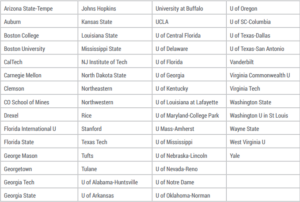The rate of women taking the helm of higher education institutions has steadily increased since ACE began collecting gender data on American presidents. Now, it seems they are beginning to break into one particularly esteemed segment of higher education: R1 research universities.
A new report by the Women’s Power Gap has discovered that more than half of all presidents appointed to an R1 research university since May 2021 were female (53%). Now, the percentage of women presidents serving the nation’s most elite universities has increased by 8% in the last two years, totaling 30%.
Ten of the 20 schools to have appointed a female president are doing so for the first time in school history. These schools include Columbia, Dartmouth, George Washington, New York University, Ohio University, Oregon State, Penn State, University of Maryland Baltimore County, University of Pittsburgh and University of Texas at Arlington.
Among the cream of the crop of R1 universities, 75% of the Ivy Leagues are now led by a woman. Dartmouth, Harvard, UPenn appointed a female president in 2022. Minouche Shafik of Columbia is the most recent selection in January of this year. Consequently, Princeton and Yale are the only two Ivy League schools currently led by a man, the latter now being the only Ivy school to have never elected a female president.
More from UB: Why these school leaders are clashing with students’ free speech judgment
Areas of improvement
Despite leadership gains for women, 57 schools have never had a woman in charge, which is about 40% of all R1 universities. At the state level, four out of six of Florida’s R1 universities have ever been led by a woman (67%), three out of four in Georgia (75%) and five out of eight in Massachusetts (62%). On the other hand, seven out of 11 R1 universities in Texas have been led by a woman. Interim presidents are not included in these figures.

Women of color and different ethnicities have made the least gains in school leadership. Despite female leadership increasing by 8% in two years, those of color only gained a 1% foothold. Moreover, of the 30% of women currently president, 3% are Asian, 2% are black and 1% are Hispanic. Similarly, men of color or various ethnicities aren’t adequately represented compared to their proportion of the U.S. population. While Hispanics make up roughly 19% of the nation, only 4% of Hispanic men currently serve as a president of R1 universities.
If we look at higher areas of leadership above the presidency of a single institution, fewer than 30% of board chairs are women. Even worse, no woman currently leads an independent university system.
To view recommendations on how to boost leadership equity, download the report Women’s Power Gap’s recommendations and matrix template here.








